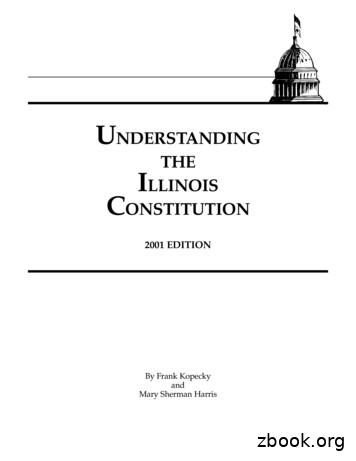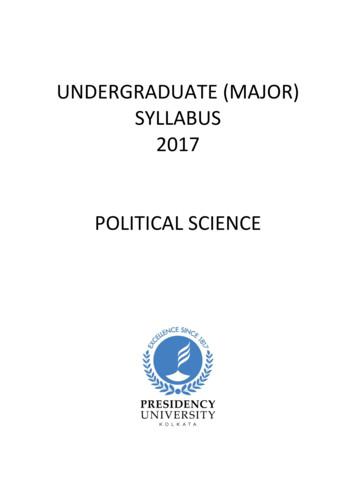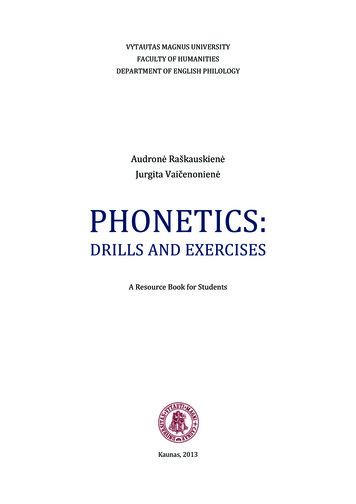1970 Illinois Constitution
1970ILLINOISCONSTITUTIONA N N O TAT E D F O R L E G I S L AT O R SFOURTH EDITION
JOINT COMMITTEE ONLEGISLATIVE SUPPORT SERVICESPresident of the Senate& ChairmanHouse Republican LeaderSpeaker of the HouseSenate Republican LeaderSen. Emil Jones, Jr.Rep. Tom CrossRep. Michael J. MadiganSen. Frank WatsonLEGISLATIVE RESEARCH UNITCo-ChairmanCo-ChairmanExecutive DirectorSenatorsDon HarmonJohn O. JonesJames T. MeeksDale RisingerCarol RonenRep. Sara FeigenholtzSen. Larry K. BomkePatrick D. O’GradyRepresentativesConstance A. “Connie” HowardSusana MendozaJames H. “Jim” MeyerEd Sullivan, Jr.The Legislative Research Unit is the central research agency forthe General Assembly. A board of 12 legislators, appointed bythe Joint Committee on Legislative Support Services, supervisesits operations.A staff of researchers handles inquiries from legislators, legislative committees, and partisan staff. The staff’s areas ofexpertise include law generally, science and technology, taxation,education, local government, economics and fiscal affairs, andthe political and social history of Illinois.
1970 Illinois ConstitutionAnnotated for Legislators4th Edition,updated 2005Written byDavid R. MillerSenior Staff Attorney andDeputy Director for ResearchPublication 314Copyright 2005Illinois Legislative Research Unit
Contents ICONTENTSPageIntroduction . VPreambleArticle 1. Bill of Rights .3Section 1.Section 2.Section 3.Section 4.Section 5.Section 6.Section 7.Section 8.Section 8.1.Section 9.Section 10.Section 11.Section 12.Section 13.Section 14.Section 15.Section 16.Section 17.Section 18.Section 19.Section 20.Section 21.Section 22.Section 23.Section 24.Inherent and Inalienable Rights .3Due Process and Equal Protection .3Religious Freedom .5Freedom of Speech .5Right to Assemble and Petition.6Searches, Seizures, Privacy and Interceptions.6Indictment and Preliminary Hearing.7Rights After Indictment.8Crime Victim’s Rights.9Bail and Habeas Corpus.10Self-Incrimination and Double Jeopardy .10Limitation of Penalties After Conviction. 11Right to Remedy and Justice.12Trial by Jury .12Imprisonment for Debt.13Right of Eminent Domain.14Ex Post Facto Laws and Impairing Contracts.14No Discrimination in Employment and the Sale or Rental of Property .16No Discrimination on the Basis of Sex.16No Discrimination Against the Handicapped .17Individual Dignity.17Quartering of Soldiers.17Right to Arms.18Fundamental Principles.18Rights Retained.18Article 2. The Powers of the State .19Section 1.Section 2.Separation of Powers .19Powers of Government .20Article 3. Suffrage and Elections .4.5.6.Voting Qualifications .21Voting Disqualification .21Elections.22Election Laws.22Board of Elections.23General Election.23Article 4. The Legislature —Power and Structure.25Legislative Composition .26Legislative Redistricting .27Election .29
II ContentsSection 5.Section 6.Section 7.Section 8.Section 9.Section 10.Section 11.Section 12.Section 13.Section 14.Section 15.Sessions.29Organization.30Transaction of Business .31Passage of Bills .31Veto Procedure .35Effective Date of Laws .37Compensation and Allowances .38Legislative Immunity .38Special Legislation.38Impeachment.39Adjournment .40Article 5. The Executive .41Section 1.Section 2.Section 3.Section 4.Section 5.Section 6.Section 7.Section 8.Section 9.Section 10.Section 11.Section 12.Section 13.Section 14.Section 15.Section 16.Section 17.Section 18.Section 19.Section 20.Section 21.Officers.41Terms.41Eligibility .41Joint Election .42Canvass—Contests .42Gubernatorial Succession.42Vacancies in Other Elective Offices.43Governor—Supreme Executive Power.43Governor—Appointing Power.43Governor—Removals .44Governor—Agency Reorganization .45Governor—Pardons .45Governor—Legislative Messages.46Lieutenant Governor—Duties.46Attorney General—Duties .46Secretary of ��Duties.48Records—Reports .48Bond.48Compensation .48Article 6. The Judiciary .51Section 1.Section 2.Section 3.Section 4.Section 5.Section 6.Section 7.Section 8.Section 9.Section 10.Section 11.Section 12.Section 13.Section 14.Section 15.Section 16.Section 17.Section 18.Section 19.Courts.51Judicial Districts.52Supreme Court—Organization .52Supreme Court—Jurisdiction.52Appellate Court—Organization .53Appellate Court—Jurisdiction .54Judicial Circuits .54Associate Judges .55Circuit Courts—Jurisdiction .55Terms of Office .56Eligibility for Office.56Election and Retention.56Prohibited Activities.57Judicial Salaries and Expenses—Fee Officers Eliminated .58Retirement—Discipline .58Administration .61Judicial Conference.61Clerks of Courts .62State’s Attorneys—Selection, Salary .62
Contents IIIArticle 7. Local ctionSectionSection1.2.3.4.5.6.7.8.Section 9.Section 10.Section 11.Section 12.Municipalities and Units of Local Government.63County Territory, Boundaries and Seats .63County Boards .63County Officers.64Townships .65Powers of Home Rule Units .66Counties and Municipalities Other Than Home Rule Units .75Powers and Officers of School Districts and Units of Local GovernmentOther Than Counties and Municipalities .75Salaries and Fees.76Intergovernmental Cooperation .77Initiative and Referendum.78Implementation of Governmental Changes .78Article 8. Finance .79SectionSectionSectionSection1.2.3.4.General Provisions .79State Finance.80State Audit and Auditor General .81Systems of Accounting, Auditing and Reporting.81Article 9. Revenue.83Section 1.Section 2.Section 3.Section 4.Section 5.Section 6.Section 7.Section 8.Section 9.Section 10.State Revenue Power .83Non-Property Taxes—Classification, Exemptions, Deductions,Allowances and Credits .83Limitations on Income Taxation .84Real Property Taxation.85Personal Property Taxation .85Exemptions From Property Taxation .86Overlapping Taxing Districts .87Tax Sales .87State Debt.88Revenue Article Not Limited .89Article 10. Education .91Section 1.Section 2.Section 3.Goal—Free Schools .91State Board of Education—Chief State Educational Officer.91Public Funds for Sectarian Purposes Forbidden .92Article 11. Environment .93Section 1.Section 2.Public Policy—Legislative Responsibility .93Rights of Individuals.93Article 12. Militia mbership .95Subordination of Military Power .95Organization, Equipment and Discipline .95Commander-in-Chief and Officers .95Privilege From Arrest.96Article 13. General Provisions ation for Public Office .97Statement of Economic Interests .97Oath or Affirmation of Office .98Sovereign Immunity Abolished .98
IV n and Retirement Rights.99Corporations.100Public Transportation .101Branch Banking .101Article 14. Constitutional nstitutional Convention .103Amendments by General Assembly.104Constitutional Initiative for Legislative Article .105Amendments to the Constitution of the United States.106Transition Schedule .107Endnotes .111Index .130
Contents VINTRODUCTIONThis publication includes the text of the 1970 Constitution as amended through the November2004 election (in boldface); commentary describing relevant court decisions, laws, and Attorney General’s opinions; and a detailed index to the Constitution’s text. Since it is written primarily for legislators, it emphasizes the constitutional structures of state and local government; legislative powers andprocedures; and limitations on statutes. But we believe that, like its predecessor editions, it will be auseful reference work for persons in all three branches of Illinois government.The idea of publishing an annotated Illinois Constitution was conceived by Associate Director Gerald L. Gherardini and sponsored by Senator Dawn Clark Netsch in 1979. To some degree itcarries forward the work of George D. Braden and Rubin G. Cohn in The Illinois Constitution: AnAnnotated and Comparative Analysis (1969), which served as a comprehensive guide for delegatesat the 1970 constitutional convention. A more direct model is the Congressional Research Service’sThe Constitution of the United States of America: Analysis and Interpretation which is periodicallyupdated for use by members of Congress.This publication was written in 1996 by David R. Miller, Deputy Director for Research, whoupdated it with major developments for this 2005 edition.Patrick D. O’GradyExecutive Director
PREAMBLEWe, the People of the State of Illinois—grateful to Almighty God forthe civil, political and religious liberty which He has permitted us to enjoyand seeking His blessing upon our endeavors—in order to provide for thehealth, safety and welfare of the people; maintain a representative andorderly government; eliminate poverty and inequality; assure legal, socialand economic justice; provide opportunity for the fullest developmentof the individual; insure domestic tranquility; provide for the commondefense; and secure the blessings of freedom and liberty to ourselves andour posterity—do ordain and establish this Constitution for the State ofIllinois.
Article 1 Bill of Rights 3Article 1. Bill of RightsThe Bill of Rights contains many protections for persons against actions by the stateand its subdivisions, including local governments. Some of the antidiscrimination provisions also apply to private businesses. Many sections of Illinois’ Bill of Rights are based onprovisions in the U.S. Constitution. In addition, the U.S. Supreme Court has held that mostprovisions in the U.S. Constitution’s Bill of Rights apply to states through the U.S. Constitution’s Fourteenth Amendment, which prohibits states from depriving any person of life,liberty, or property without due process of law. But the Illinois Bill of Rights is significantbecause a few of those federal protections do not apply to state governments, and some of theIllinois protections go beyond the scope of federal ones that do apply.SECTION 1. INHERENT AND INALIENABLE RIGHTSAll men are by nature free and independent and have certain inherent and inalienable rights among which are life, liberty and the pursuit of happiness. To secure theserights and the protection of property, governments are instituted among men, derivingtheir just powers from the consent of the governed.These familiar words from the Declaration of Independence have appeared in someform in each of Illinois’ four Constitutions (1818, 1848, 1870, and 1970). They are treatedas mostly hortatory, stating ideals rather than setting specific standards. But the courts havein a few cases cited them, along with other constitutional provisions, in striking down lawsthat unreasonably prohibited or restricted occupations, such as a plumber licensing law thatallowed master plumbers to determine how many persons could become plumbers1 and a lawprohibiting the making of industrial coils and springs at home when no danger from the practice was shown.2SECTION 2. DUE PROCESS AND EQUAL PROTECTIONNo person shall be deprived of life, liberty or property without due process oflaw nor be denied the equal protection of the laws.Due process“Due process of law” is an exceedingly broad principle. It includes the right to havedecisions that affect oneself made by established procedures that are designed to be fair(“procedural due process”) and also sometimes the right to be free from unwarranted government coercion (“substantive due process”). Due process requires among other things that alaw, especially a criminal one, give adequate notice of what conduct it prohibits;3 that personswho are to be adversely affected by an administrative or judicial action be given notice andan opportunity to be heard in opposition;4 and that the hearing not be biased or otherwise unfair.5 However, the courts uphold a large majority of laws challenged under due process.Due process of law was guaranteed by the 1870 Constitution. It is now guaranteed bythe U.S. Constitution’s Fifth Amendment, which applies to the national government, and byits Fourteenth Amendment which applies to the states.Equal protectionThe guarantee of equal protection of the laws is taken from the U.S. Constitution’sFourteenth Amendment, added after the Civil War. This concept originally was intended toprohibit government from enforcing laws unequally, but has since become more important asa protection against laws that are themselves unequal, discriminating on grounds not relatedto a valid governmental purpose. Although the 1870 Illinois Constitution did not specifically guarantee equal protection, the Illinois courts long before 1970 had held that the 1870
4 Article 1 Bill of RightsConstitution’s prohibition against “local or special laws” guaranteed equal protection of thelaws.6 The Illinois Supreme Court has said that it uses the same analysis for equal-protectionclaims under the U.S. and Illinois Constitutions.7A person claiming denial of equal protection generally argues either that (1) two similar persons are being treated differently, or (2) two persons who should be treated differentlyare being treated alike. To decide such a claim, a court must determine what class or classesthe law or other government action has created, and whether those classes are sufficientlyrelated to a constitutionally valid objective. Some cases decided under the old (1870) Constitution said that the legislature cannot, merely by defining terms, cause a class to includepersons who in common understanding are not within that class.8 While those cases mayembody a stricter approach to statutes than the courts now employ, they do make an important point: The mere act of defining a term cannot save a statutory classification that violatesequal protection.Rational basis standardIn cases on due process and equal protection, the courts apply differing levels ofscrutiny depending on the nature of the interest being protected and (for equal protection)the kind(s) of classification involved. In most situations the courts will uphold a st
Due process of law was guaranteed by the 1870 Constitution. It is now guaranteed by the U.S. Constitution's Fifth Amendment, which applies to the national government, and by its Fourteenth Amendment which applies to the states. Equal protection cally guarantee equal protection, the Illinois courts long before 1970 had held that the 1870
Constitution to be considered duly elected Under Constitution b. Swearing in of Newly Elected President on April 12, 1985 and coming into Forces of Constitution c. Convening of Newly elected Legislature d. Position of Persons Appointed Prior to Coming into Forces of Constitution 95. a. Abrogation of Constitution of July 26, 1847 b.
Creative Die Mold Corp. Glendale Heights, Illinois Simmons Knife & Saw Glendale Heights, Illinois J.H. Botts LLC Joliet, Illinois Termax Corporation Lake Zurich, Illinois RG Manufacturing Machesney Park, Illinois Metal Resource Solutions McHenry, Illinois Lyon LLC Montgomery, Illinois Sko-Die, Inc. Morton Grove, Illinois NTN USA Corporation
constitution test. You will be studying the Declaration of Independence, the United States Constitution, the U.S. flag, and the Illinois Constitution. If you study these materials, you will be able to successfully pass the constitution test. This Study Guide is divided into lessons. Each lesson includes specific directions to assist you.
drafted the constitution met for only twenty-one days and produced a constitution that was relatively short. It was modeled after the U.S. Constitution and the state constitutions of Kentucky, Ohio, and Indiana. One of the main issues when the 1818 Constitution was drafted was that of slavery. Several early settlers
Understanding the Illinois Constitution is designed for use as a supplemental text in history or government courses. It was written with the assumption the reader would have some familiarity with the United States Constitution. Throughout the text, references and comparisons are made to the United States Constitution;
Alladi Krishnaswami Aiyer, Constitution and Fundamental Rights. D. N. Sen, From Raj to Swaraj Durga Das Basu, Introduction to the Constitution of India. Durga Das Basu, Shorter Constitution of India. Granville Austin, The Indian Constitution: Cornerstone of a Nation. Granville Austin, Working a Democratic Constitution: The Indian experience.
Constitution of Kappa Kappa Psi.) 3.06 This Constitution is superseded by the National Constitution of Kappa Kappa Psi unless otherwise stated and approved by the National Council. 4. Constitutional Amendments 4.01 Proposed amendments to this Constitution shall be presented in writing at the regularly-called District
The present resource book is designed as a supplement to Peter Roach’s (2010) textbook English Phonetics and Phonology: A Practical Course and may be used to accompany lecture courses on English Phonetics at university level. It is equally suitable for self‐study and for in‐class situation























